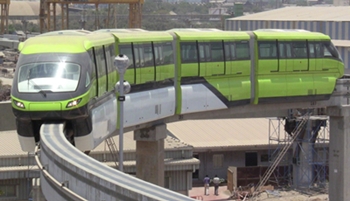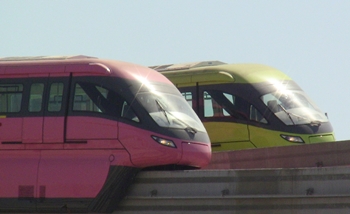Monorail as a mass transit system
31 Oct 2012
 Despite the ongoing global economic downturn, India is expected to continue to show a healthy positive growth. According to a recent report by Dun & Bradstreet, agriculture, physical infrastructure and social infrastructure are the key growth drivers that will enable the economy to achieve comprehensive growth in the coming years.
Despite the ongoing global economic downturn, India is expected to continue to show a healthy positive growth. According to a recent report by Dun & Bradstreet, agriculture, physical infrastructure and social infrastructure are the key growth drivers that will enable the economy to achieve comprehensive growth in the coming years.
With growth comes increased pressure on infrastructure, and an increased thrust on development of transportation infrastructure. The government has announced 2010-2020 as the decade of innovation in transportation to interlink cities and towns and push for overall economic growth.
Government research shows that the share of buses in public transport has gone down from 11 per cent in 1951 to merely 2 per cent in the last decade with no major development happening in the last 60 years.
It's evident that there is increasing pressure on urban transport and existing systems are not sufficient to meet growing demand. There is increased usage of private vehicles, further clogging existing road infrastructure.
Thus, improvising public transportation systems assumes significance. The best approach to strengthen public transport is to seamlessly integrate better modes of commuting in densely populated metros like Mumbai, Delhi, Chennai and Kolkata and other fast-growing cities across the countryand other fast-growing cities across the country.
Mumbai along with a few other cities have started implementing mass rapid transit systems (MRTS) to serve growing population.
The Maharashtra government and urban infrastructure authorities in Mumbai have put together a comprehensive transport infrastructure makeover plan.
The city is set to witness an advanced, integrated multi-modal transport system that promises to shape the city's transport infrastructure into an organised framework.
Apart from the metro rail project and the bus rapid transit system (BRTS), the city will also be home to the country's first-ever monorail project.
 The Mumbai Monorail Project is being executed by Malaysia's Scomi Engineering and its consortium partner Larsen & Toubro, under the Mumbai Metropolitan Region Development Authority's (MMRDA) jurisdiction in 2008.
The Mumbai Monorail Project is being executed by Malaysia's Scomi Engineering and its consortium partner Larsen & Toubro, under the Mumbai Metropolitan Region Development Authority's (MMRDA) jurisdiction in 2008.
The Mumbai Monorail Project covers a 20-km dual-phased monorail route, covering the major nerve centres across Mumbai, from Jacob Circle-Wadala-Chembur route, which will be the first to be operational in the country, is the second-longest route in the world after the Osaka monorail corridor in Japan, which is 23.8km-long.
As per the MMRDA plan, a monorail with four cars will have a capacity to ferry 562 passengers, while one with six cars will be able to accommodate 852 commuters.
Since Mumbai is densely populated, a monorail is the most viable option available, for it can easily move through the city's narrow corridors taking tight turns; a larger capacity railway project poses several problems, starting with land availability and time to execute. Therefore a monorail often becomes a default solution in providing speedy mass transit.
Universally, monorails are regarded as the most suitable mode of travel in urban nerve centres due to their manoeuvrability that improves connectivity and saves travel time.
Its construction does not involve dismantling existing structures or road widening . The light weight of the monorail coaches and fewer infrastructural requirements also reduce the time gap between conception and execution of the project.
 The Mumbai monorail project also aims to reduce pollution caused by other public transportation systems as it follows the green transportation model and will be powered by electric motors which are silent, efficient and clean.
The Mumbai monorail project also aims to reduce pollution caused by other public transportation systems as it follows the green transportation model and will be powered by electric motors which are silent, efficient and clean.
Monorail coaches move on rubber tyres on concrete beams creating less noise and vibrations during operation.
Investment in a transport system like the monorail also proves cost-effective as it offers increased cost savings during construction.
It requires only a single beam and is elevated and occupies lesser physical space than other rail networks
The first phase of trial run was successfully completed in February 2012. The second phase of testing and commissioning is scheduled in November, followed by the commencement of commercial services shortly thereafter.
Once operational, the Mumbai monorail would be a major step in multi-modal point-to-point rapid transportation connectivity.
Incidentally, the Mumbai project is drawing interest across leading cities in the country. With its advantages as a medium of mass transit, monorails are expected to become the transport of the future in urban centres, providing efficient, sustainable and comfortable modes of public travel across the country.






























